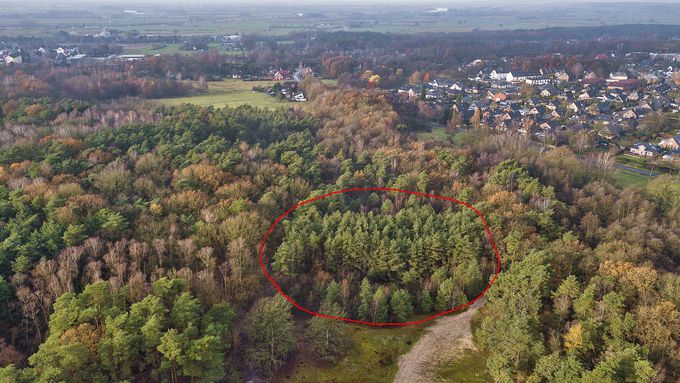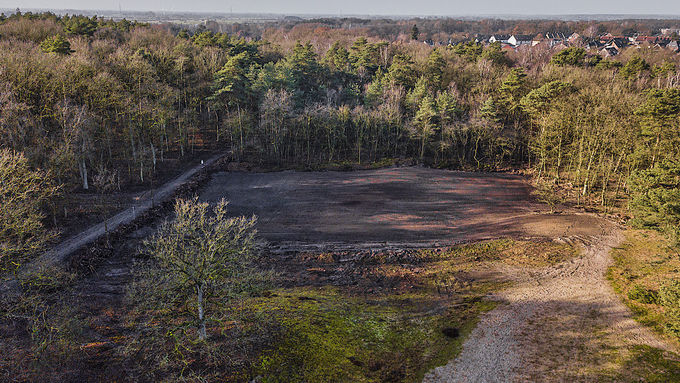The area in the Verden dunes before the works started © Arne von Brill
main content
Project of the month
#2/2021 LINKING-UP AND EXPANSION OF ISOLATED OPEN DUNE AREAS IN THE SAC ‘DÜNENGEBIET BEI NEUMÜHLEN’
The desert as an oasis
As early as 1930, the Verden dunes became a protected area. In 2018, the existing decree was replaced by the nature reserve ‘Dünengebiet und Halsetal bei Verden-Neumühlen’. This inland dune landscape is unique in its characteristics and provides habitat for rare animal and plant species. The inland dunes were formed during the ice ages. The soil was washed and deposited into the Aller lowlands by meltwater and rain. While fine material such as clay and silt was transported up to the edge of the low mountain range, the coarser, nutrient-poor sand was deposited as dunes at the edge of the floodplain. Today, there are only few active dune areas left. Due to their rarity, they are protected EU-wide as habitat type ‘Inland dunes with open Corynephorus and Agrostis grasslands’ (2330).
Many animal and plant species depend on the open, nutrient-poor sandy areas. In the Verden dunes, for example, bird species such as woodlark (Lullula arborea) and tree pipit (Anthus trivialis) can be found, as well as the northern dune tiger beetle (Cicindela hybrida), the black-banded spider wasp (Anoplius viaticus) or the blue-winged grasshopper (Oedipoda caerulescens) among the insects. Due to various adaptation strategies, plants such as sand sedge (Carex arenaria), grey hair-grass (Corynephorus canescens) and common heather (Calluna vulgaris) grow in the Verden dunes. Lichens - communities of algae and fungi - occur in large areas and form the so-called ‘lichen lawns’.
However, without management or restoration measures, this open habitat cannot be preserved. Nutrient inputs from the air, caused by agricultural fertilisation and traffic, but also a lack of wind influence and foliage accumulation, favour fast-growing plant species and promote succession. Non-native conifers and massively spreading stands of black cherry (Prunus serotina) thus threatened the typical light-demanding dune vegetation in the Verden dunes and thus also the habitat of the adapted animal species.
Already in 2011, the Lower Nature Conservation Authority of the District of Verden began to open up dune areas very successfully by removing overgrown woody plants in the Verden dunes. Within the framework of the LIFE IP Atlantic Region DE, it has now been possible to open up further areas in the dunes in co-operation with the NLWKN project team. Formerly open dune areas were cleared successively in 2020 in an area of about 2.35 hectares by removing overgrown woody plants, in particular black cherry, thus connecting isolated areas with each other.
The tree stumps resulting from the clearing were deposited at suitable sites in the area as shelter for reptiles such as the sand lizard (Lacerta agilis). Single landscape-characterizing trees remained in the areas. In the next step, the soil, which only had a small humus layer, was carefully milled so that the sand came to rest on the surface. The natural dune relief was preserved. In this way, the topsoil did not need to be removed and transported away. Any remaining humus is further reduced naturally by washouts during rainfall. The Lower Nature Conservation Authority had already gained experience in this type of soil cultivation before and introduced it into the implementation of the measures within the framework of the LIFE Integrated Project. The action was implemented on land owned by the District and the City of Verden.
In order to bring interested people closer to this special habitat, a dune experience trail with information boards and visitor guidance was built.
Related topics
Further links
- Informationen upon the nature reserve ‘Dünengebiet und Halsetal bei Verden-Neumühlen’ – Niedersächsischer Landesbetrieb für Wasserwirtschaft, Küsten- und Naturschutz (in German) (external link opens in a new window)
- Lower Nature Conservation Authority of the District of Verden, Department ‘Water, Waste and Conservation’ (in German) (external link opens in a new window)





